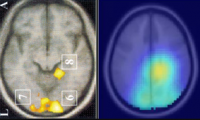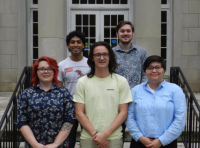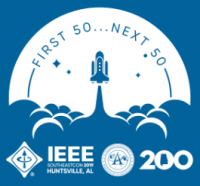Lab Information
Hi5 Seminar Series
Tutorials/How-Tos
Lab Information
Hi5 Seminar Series
Tutorials/How-Tos
The High Fidelity Virtual Environments (Hi5) Lab resides in the Department of Computer Science & Engineering at Mississippi State University. We combine computer science, neuroscience, and psychology to perform novel research examining human performance and behavior in VR/AR/MR.
— Adam Jones w/ Hi5 Bot - 2025/06/20 (post-dated)
Beginning this fall, Mississippi State University will offer a new minor in Applied Neuroscience, an interdisciplinary program that explores how the brain supports perception, thought, and behavior—and how that knowledge can be applied in real-world contexts. This 18-credit program is designed to serve students from a wide range of majors, including engineering, psychology, biology, and computer science. This effort is a collaboration across 4 colleges and 9 departments and would not possible without the support and enthusiasm of many many people.
The new minor is a direct extension of work happening in the High Fidelity Virtual Environments Lab and is a key part of my NSF CAREER Award’s educational goals. Our research combines vision science, neuroimaging, and immersive technology to better understand how people perceive space and act within virtual environments. The minor gives students the opportunity to build that same foundation—starting with core neuroscience and branching into electives aligned with their interests and career paths.
This initiative reflects MSU’s commitment to growing cross-disciplinary education and research in neuroscience. I’m grateful to the many faculty across departments who contributed to its development, and I look forward to seeing the new directions our students take as this program grows.
— Adam Jones w/ Hi5 Bot - 2024/06/14 (post-dated)
This summer, I had the opportunity to partner with the Starkville-Oktibbeha County School District to host an NSF supported week-long summer camp focused on virtual reality development for students in grades 5 through 7.
Over the course of five days, 14 students explored the foundations of VR—from hardware and optics to storytelling and interaction design. They worked cutting edge VR headsets and industry standard technologies to build a virtual world! Each day combined hands-on activities, short lectures, and collaborative problem-solving. Topics ranged from the history of VR to motion capture, visual storytelling, and prototyping.
This outreach initiative is part of my NSF CAREER Award’s broader mission to connect cutting-edge research in immersive technology with K-12 education. I’m proud of what the students built—and even more excited about the curiosity and confidence they brought into the classroom each morning.
We’re looking forward to continuing this each summer, with the goal of making immersive tech education more accessible, tangible, and fun for students in our community.
— Adam Jones w/ Hi5 Bot - 2024/03/14 (post-dated)
I’m deeply honored to receive a National Science Foundation’s Faculty Early Career (CAREER) Award, a five-year grant to support our research on how the brain perceives space using virtual reality.
This award will enable the High Fidelity Virtual Environments Lab to combine ophthalmological models, neuroimaging, and psychophysical techniques to ask questions that have traditionally been out of reach. I’m both thrilled and humbled by the confidence NSF and Mississippi State have placed in our team to educate the next generation of curious minds. Over the coming years, we’ll bring students into experiments, seminars, and public outreach that weave together computer science, neuroscience, psychology, and vision science.
We’re ready to roll up our sleeves, investigate new directions, and build tools that could transform fields. It’s an exciting journey ahead—and I’m profoundly grateful to have this opportunity.
— Adam Jones w/ Hi5 Bot - 2023/08/08 (post-dated)
I’m excited to share that our lab participated in SIGGRAPH 2023’s Cabinets of Computer Graphics Curiosities, part of the conference’s 50th anniversary celebration. Our early 3D-printed and DIY virtual reality displays—some never seen outside the lab—were showcased among artifacts celebrating computer graphics history.
SIGGRAPH’s history exhibits were framed within the larger Time Tunnel and the immersive “50 Years at a Glance” installations, offering context for breakthroughs over the past five decades (ACM SIGGRAPH Blog). Within the Cabinets, attendees could explore physical prototypes and artifacts that tell the story of our field beyond code and pixels.
It was a privilege to place our collection (and memories) alongside pioneering systems and artifacts from across academia and industry. Some of our prototypes (built by me, my students, and colleagues over the years) had never been publicly exhibited before. Seeing them displayed in this exhibit underscores how far the field has come.
Thank you to the SIGGRAPH History Committee, including History Chair Bonnie Mitchell and coordinator Dave Kasik, for bringing this vision to life and including our work in the Cabinets of Computer Graphics Curiosities.
Being part of a milestone event like SIGGRAPH’s 50th anniversary exhibit was a meaningful moment for our lab. It reaffirmed how hands-on innovation, from 3D printing to DIY electronics, helps shape the future of VR and graphics. I’m proud of our contributions and motivated to continue building tools and labs that span disciplines and spark curiosity.
— Adam Jones w/ Hi5 Bot - 2022/11/1 (post-dated)
We were exceptionally lucky to receive a National Science Foundation Convergence Accelerator grant along with the T.K. Martin Center for Technology and Disability, the Center for Advanced Vehicular Systems, the College of Education, and the Mississippi Department of Rehabilitation Services to develop DriVR, a customizable VR-based driving simulation platform.
In rural areas, where public transportation is limited or nonexistent, independent driving is often essential for access to education, employment, and community life. For some individuals with disabilities, however, traditional driver training may be difficult to access or insufficiently adapted to their needs. DriVR is meant to address this gap using affordable, off-the-shelf.
DriVR is intended to allow driver rehabilitation specialists to create safe, personalized training experiences that include everything from parking and lane changes to traffic stops and unexpected hazards. The platform can be adapted for users with mobility challenges—including hand controls—or for those who need extra time or support to build confidence behind the wheel.
The project’s long-term goal is to expand access to this kind of adaptive training and contribute to broader efforts that support independence, employment, and quality of life for people with disabilities. We’re grateful to our partners and excited to continue building tools that can make a meaningful difference.
— Adam Jones 2022/5/9 11:22
Hi5 grad student Zack Garris is investigating spatial audio in MSU's “quietest room”. Pictured here is his study at the MSU Raspet Flight Lab's specially designed anechoic chamber.
3-D for our ears! Bagley College of Engineering professor Adam Jones seeks improvements to virtual reality by studying spatial audio (think more realistic surround sound). He used Mississippi State University’s quietest room, our acoustic anechoic chamber, to record audio for a study. We built the chamber for researching methods to quieten unmanned aircraft systems, and its capacity to absorb sound waves makes it well suited for Jones’ baseline work. Jones and grad student Zack Garris seek to improve the realism of VR by better understanding how our brains process sensory information. The pair are recording audio samples in multiple locations exhibiting different types of reverberation.
— Adam Jones 2022/4/4 17:00
Congratulations to Hi5 students Maggie Pettus, Zack Garris, and D.J. Molsbarger for having their preliminary research on improving neuroimaging via EEG using low-cost, off-the-shelf VR hardware accepted for presentation at the Mississippi Academy of Sciences!
ABSTRACT: Electroencephalography (EEG) is a robust and useful tool for better understanding function within the human brain. Though EEG is often used to analyze gross, time-course changes in brain activity with high temporal resolution, it can also be used to perform low resolution source localization of activity within the brain. However, for source localization to be accurate, the exact location of the system's electrodes must be known relative to each other and the user's head. Several approaches such as using MRI, professional motion capture, or 3D scanning have been employed to measure the position of electrodes with a high degree of accuracy. Unfortunately, these approaches are often time consuming and not cost-effective. In this poster, we propose a low cost, high accuracy method of measuring the position of electrodes for the purposes of source localization with EEG. Modern virtual reality (VR) systems have greatly decreased in cost and have become widely available to the public. These systems can be roughly generalized as being a hybrid of two distinct computational systems: a display device and a motion capture system. Our previous work has shown that these low-cost VR systems can provide motion capture and positional measurements comparable to professional motion capture systems while costing multiple orders of magnitude less. We demonstrate in the current work that, with no hardware modification, an off-the-shelf VR system can be repurposed to perform fast, accurate 3D localization of electrodes on a standard EEG cap.
— Adam Jones 2021/11/2 17:12
Join us for an encore presentation of “Extended Reality: Extending Human-Centered Research” as part of the Introduction to Computer Science and Engineering seminar series. This presentation will be held on Monday, November 15, at 5:30 PM in the Harned Hall, Room 102.
ABSTRACT: Extended Reality (XR) refers to a wide range of “reality” altering technologies including virtual, augmented, and mixed reality. XR technologies have become more widely available through smartphones, virtual reality headsets, and other wearable devices. The diversity of topics that a scientist or developer encounters when studying XR can be strikingly broad. Often, we need to have at least some understanding of perceptual psychology, biomechanics, software development, digital devices, and computer graphics. You can think of these topics as being a new kind of skill-stack that encompasses the tools needed to be a highly competitive XR developer or researcher. The necessary diversity of XR development is presently fueling innovations and collaborations across a wide range of areas within science and engineering. As a result, there are new and exciting opportunities for students interested in building careers in XR development, as well as for scientists looking to broaden the scope of their research. In this talk, I will give an overview of some of the research and educational activities in the High Fidelity Virtual Environments Lab (Hi5 Lab) that furthers the goal of producing exceptional XR scientists and developers.
— Adam Jones 2021/10/12 11:59
On Friday, October 22, at 3:00 PM, Dr. Jones will be giving a talk entitled “Extended Reality: Extending Human-Centered Research” at the Mitchell Memorial Library (Room 1405).
ABSTRACT: Extended Reality (XR) refers to a wide range of “reality” altering technologies including virtual, augmented, and mixed reality. XR technologies have become more widely available through smartphones, virtual reality headsets, and other wearable devices. The diversity of topics that a scientist or developer encounters when studying XR can be strikingly broad. Often, we need to have at least some understanding of perceptual psychology, biomechanics, software development, digital devices, and computer graphics. You can think of these topics as being a new kind of skill-stack that encompasses the tools needed to be a highly competitive XR developer or researcher. The necessary diversity of XR development is presently fueling innovations and collaborations across a wide range of areas within science and engineering. As a result, there are new and exciting opportunities for students interested in building careers in XR development, as well as for scientists looking to broaden the scope of their research. In this talk, I will give an overview of some of the research and educational activities in the High Fidelity Virtual Environments Lab (Hi5 Lab) that furthers the goal of producing exceptional XR scientists and developers.
— Adam Jones 2021/8/24 18:09
 On Friday, September 3, at 12:00 PM, Dr. Jones will present an XR research seminar as part of the ACCESS seminar series in Cognitive Science. The seminar will be in Old Main 2130. XR gives us an unparalleled opportunity to study aspects of perception, action, and cognition that have not been previously possible. Please join us for an exciting discussion of the research conducted by the Hi5 Lab.
On Friday, September 3, at 12:00 PM, Dr. Jones will present an XR research seminar as part of the ACCESS seminar series in Cognitive Science. The seminar will be in Old Main 2130. XR gives us an unparalleled opportunity to study aspects of perception, action, and cognition that have not been previously possible. Please join us for an exciting discussion of the research conducted by the Hi5 Lab.
— Adam Jones 2021/08/16 12:00
 The Hi5 Lab has recently moved to the Department of Computer Science and Engineering at Mississippi State University. We are proud of all the outstanding students who have graduated as members of Hi5 at our previous institution, and we look forward to graduating many more in the years to come! We are excited about the new collaborations, projects, and team members here at Mississippi State. You will still be able to find updates and information about the Hi5 Lab at our website: hi5lab.org.
The Hi5 Lab has recently moved to the Department of Computer Science and Engineering at Mississippi State University. We are proud of all the outstanding students who have graduated as members of Hi5 at our previous institution, and we look forward to graduating many more in the years to come! We are excited about the new collaborations, projects, and team members here at Mississippi State. You will still be able to find updates and information about the Hi5 Lab at our website: hi5lab.org.
— Adam Jones 2020/08/18 15:07
Congratulations to Benji Creel for having his Honors Thesis research accepted for publication at the 2020 ACM Symposium on Virtual Reality Software and Technology! This work was co-authored with Dr. Colin Jackson, Dr. Caitlin Rinz-Jones, and Dr. J. Adam Jones.
As commodity virtual reality (VR) systems become more common, they are rapidly gaining popularity for entertainment, education, and training purposes. VR utilizes headsets which come in contact with or close proximity to the user's eyes, nose, and forehead. In this study, the potential for these headsets to become contaminated with bacteria was analyzed. The nosepieces and foreheads of two HTC Vive headsets were sampled over the course of a seven-week period in a VR software development course. Serial dilutions were performed, and samples were plated on various culture media. Following incubation, counts of bacteria were determined. DNA was extracted from bacterial colonies and the 16S rRNA gene was sequenced to identify bacterial contaminates present on the headsets. Chief among these contaminates was Staphylococcus aureus. The results of these tests indicated that the Staphylococcus aureus strains isolated from the headsets possessed high levels of antibiotic resistance. Other notable bacterial isolates included Moraxella osloensis, the bacteria responsible for foul odors in laundry and Micrococcus luteus, a communalistic bacterial species capable of causing opportunistic infections. Other bacterial isolates were detected in variable amounts throughout the trial.
— Adam Jones 2020/06/20 20:45
 In the time of social distancing and safer-at-home policies, it is easy to lose contact and comradery with each other. For this reason, the Hi5 Lab is hosting our first virtual summer seminar series. This is geared towards keeping people who are interested in AR/VR and related topics in-touch, engaged, and apprised of the latest research, science, and engineering. Every Friday at 3:00PM Central Time (US), we will be hosting a new speaker!
In the time of social distancing and safer-at-home policies, it is easy to lose contact and comradery with each other. For this reason, the Hi5 Lab is hosting our first virtual summer seminar series. This is geared towards keeping people who are interested in AR/VR and related topics in-touch, engaged, and apprised of the latest research, science, and engineering. Every Friday at 3:00PM Central Time (US), we will be hosting a new speaker!
We have scheduled an excellent group of some of the AR/VR community's best early-career investigators to present a wide cross-section of the newest, most exciting, and groundbreaking research. Their presentations will be live-streamed to the Hi5 YouTube Channel, and recordings will be archived there for you to watch in the future!
— Adam Jones 2020/02/19 15:49
Congratulations to Hunter Finney for having his CREX research project investigating how perception and action are affected by visual illusions using virtual reality! This work will be published and presented at the 2020 IEEE Conference on Virtual Reality and 3D User Interfaces (IEEE VR). This work was co-authored with CIS faculty J. Adam Jones.
The Ebbinghaus illusion affects the perceived size of a disc enclosed by an annulus of either larger or smaller discs. Though many have seen consistent effects of the illusion on size perception, there have been mixed results when studying its effect on action-based tasks. We present a study utilizing a virtual environment to examine the illusion's effect on reaching in depth. We found that size judgments were symmetrically affected by common Ebbinghaus configurations, but their distance judgments were asymmetrically affected. Large annulus configurations had no effect on distance judgments while small annulus configurations resulted in underestimation of distances.
— Adam Jones 2020/02/19 15:40
Congratulations to Collin Roth and Ethan Luckett for having their research investigating how users of virtual reality systems perceive latency accepted for publication and presentation at the 2020 IEEE VR Workshop on Perceptual and Cognitive Issues in AR (PERCAR)! This work was co-authored with CIS faculty J. Adam Jones.
Through the history of virtual environments research there has been significant interest in understanding how latency in a system affects a user's experience. Though latency cannot be avoided, previous work has observed that there may be ranges within which small latencies are not discernible. However, the majority of the work examining latency detection thresholds was conducted using hardware and software that are no longer commonly used in contemporary research. In the current study, we examine whether similar latency tolerances exist for modern, off-the-shelf systems. We also look at the effect of increasing and decreasing latency on such tolerances. This revealed evidence of a “latency illusion” that presents in cases of decreasing latency resulting in subjects perceiving less latency than is actually present in the environment.
— Adam Jones 2020/02/19 15:26
Congratulations to Joao Paulo Marum for having his exciting work on expanding the functionality of game engines commonly used in VR and AR selected for publication and presentation a the IEEE VR Workshop on Software Engineering and Architectures for Realtime Interactive Systems (SEARIS)! This article was co-authored with CIS faculty H. Conrad Cunninghand and J. Adam Jones.
In Virtual Environments (VEs), the system must quickly respond to user actions and accurately display the result. Current solutions on the Unity3D game engine often respond too slowly and display temporarily inaccurate or misleading states, resulting in low user satisfaction. To alleviate this problem, we develop a reactive programming approach that encodes the complex relationships among Unity3D game components in a dependency graph and then uses the graph to order the updates of the components without violating the dependency constraints. This enables more timely updates and more accurate visualizations, potentially providing users with a more satisfying experience. We evaluate our approach by comparing its performance with native Unity3D and with UniRx, the Reactive Extensions library for the Unity3D platform.
— Adam Jones 2020/02/19 15:12
Congratulations to Joao Paulo Marum for having his research on reactive programming methods for web and desktop interfaces accepted for publication and presentation at the 2020 ACM Southeast Conference! This article was co-authored with CIS faculty H. Conrad Cunninghand and J. Adam Jones.
In user interfaces on Web and desktop applications, the system must quickly respond to user inputs and accurately display the result. Current solutions for user interfaces often respond too slowly and display temporarily inaccurate or misleading states, resulting in low user satisfaction. To alleviate this problem, we develop a reactive programming approach that encodes the complex relationships among the user interface components in a dependency graph and then uses the graph to order the updates of the components without violating the dependency constraints. This enables more timely updates and more accurate visualizations, potentially providing users with a more satisfying experience. We evaluate our approach by comparing its performance with important alternative reactive libraries for user interfaces.
— Adam Jones 2019/05/11 8:14
 Congratulations to Hunter Finney and Nayan Chawla for receiving the 2019-2020 CSpire Scholarship! These students are excellent undergraduates who excel in both academics and research. We're proud to have them as members of the Hi5 lab. This scholarship is only awarded to 5 students in the fields of Computer Science and Electrical Engineering. Again, congratulations and thank you for all your hard work and dedication!
Congratulations to Hunter Finney and Nayan Chawla for receiving the 2019-2020 CSpire Scholarship! These students are excellent undergraduates who excel in both academics and research. We're proud to have them as members of the Hi5 lab. This scholarship is only awarded to 5 students in the fields of Computer Science and Electrical Engineering. Again, congratulations and thank you for all your hard work and dedication!
— Adam Jones 2019/05/03 13:49
 Students from the Hi5 lab and the greater Computer & Information Science department presented their research at the 2019 IEEE SoutheastCon. A total of five papers and one poster were accepted for presentation. Student authors include Joao Paulo Marum, William Panlener, Zhonghui Wang, Khaled Sabahein, and Khoa Tran. Faculty authors include Feng Wang, Conrad Cunningham, and Adam Jones. Congratulations to you guys!
Students from the Hi5 lab and the greater Computer & Information Science department presented their research at the 2019 IEEE SoutheastCon. A total of five papers and one poster were accepted for presentation. Student authors include Joao Paulo Marum, William Panlener, Zhonghui Wang, Khaled Sabahein, and Khoa Tran. Faculty authors include Feng Wang, Conrad Cunningham, and Adam Jones. Congratulations to you guys!
— Adam Jones 2019/02/21 06:47
When VR, 3D printing, motion tracking, and circuits come together interesting things happen! A novel end-to-end latency measurement developed in collaboration with Clemson University is going to be presented at the IEEE Conference on Virtual Reality and 3D User Interfaces in Osaka, Japan.
In this paper, we discuss a generalizable method to measure end-to-end latency. This is the length of time that elapses between when a real-world movement occurs and when the pixels within a head-mounted display are updated to reflect this movement. The method described here utilizes components commonly available at electronics and hobby shops. We demonstrate this measurement method using an HTC Vive and discuss the influence of its low-persistence display on latency measurement.
— Adam Jones 2019/02/17 18:56
UM student Ethan Luckett and Rust College student Tykeyah Key are going to have their research into the measurement and evaluation of motion tracking systems presented in the Novel Input Devices and Interaction Techniques Workshop at the IEEE Conference on Virtual Reality and 3D User Interfaces in Osaka, Japan. This work was supported by the Ronald E. McNair Scholars Program and the Sally McDonnell Barksdale Honors College.
In this paper, we present three generalizable metrics by which tracking systems for virtual environments can be evaluated. These metrics include positional accuracy, rotational accuracy, and tracking resolution. Additionally, we present methods for acquiring these measurements using components commonly available at hardware and hobby shops. The methods are tested using a consumer-grade virtual reality system but are widely generalizable to most tracking systems, both professional- and consumer-grade.
— Adam Jones 2019/02/09 05:34
Work from the Hi5 Lab discussing the optical and neural properties of vision as applied to virtual reality has been accepted to the Neuroscience & Virtuality Workshop at the IEEE Conference on Virtual Reality and 3D User Interfaces in Osaka, Japan.
The physiological optics and neurology of vision are topics with much breadth and perhaps even more depth. Though many people have a cursory understanding of the visual system, there are some less-commonly known aspects that are vitally important to virtual environments research and practice. In this paper, we present an elementary discussion of the optical and neural elements involved in the early stages of vision and their relationship to virtual environments.